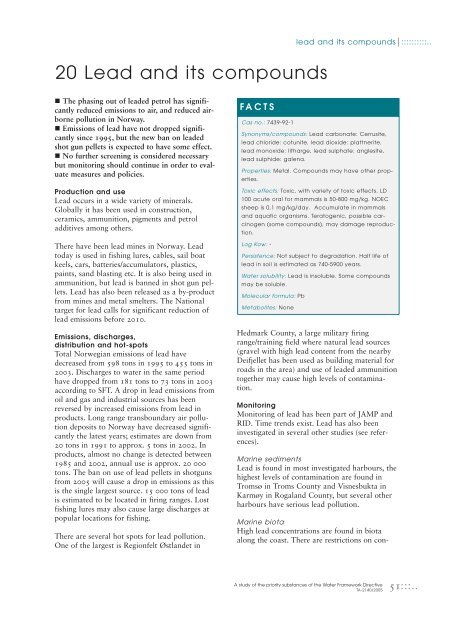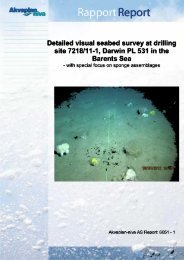A study of the priority substances of the Water Framework Directive ...
A study of the priority substances of the Water Framework Directive ...
A study of the priority substances of the Water Framework Directive ...
Create successful ePaper yourself
Turn your PDF publications into a flip-book with our unique Google optimized e-Paper software.
20 Lead and its compounds<br />
� The phasing out <strong>of</strong> leaded petrol has significantly<br />
reduced emissions to air, and reduced airborne<br />
pollution in Norway.<br />
� Emissions <strong>of</strong> lead have not dropped significantly<br />
since 1995, but <strong>the</strong> new ban on leaded<br />
shot gun pellets is expected to have some effect.<br />
� No fur<strong>the</strong>r screening is considered necessary<br />
but monitoring should continue in order to evaluate<br />
measures and policies.<br />
Production and use<br />
Lead occurs in a wide variety <strong>of</strong> minerals.<br />
Globally it has been used in construction,<br />
ceramics, ammunition, pigments and petrol<br />
additives among o<strong>the</strong>rs.<br />
There have been lead mines in Norway. Lead<br />
today is used in fishing lures, cables, sail boat<br />
keels, cars, batteries/accumulators, plastics,<br />
paints, sand blasting etc. It is also being used in<br />
ammunition, but lead is banned in shot gun pellets.<br />
Lead has also been released as a by-product<br />
from mines and metal smelters. The National<br />
target for lead calls for significant reduction <strong>of</strong><br />
lead emissions before 2010.<br />
Emissions, discharges,<br />
distribution and hot-spots<br />
Total Norwegian emissions <strong>of</strong> lead have<br />
decreased from 598 tons in 1995 to 455 tons in<br />
2003. Discharges to water in <strong>the</strong> same period<br />
have dropped from 181 tons to 73 tons in 2003<br />
according to SFT. A drop in lead emissions from<br />
oil and gas and industrial sources has been<br />
reversed by increased emissions from lead in<br />
products. Long range transboundary air pollution<br />
deposits to Norway have decreased significantly<br />
<strong>the</strong> latest years; estimates are down from<br />
20 tons in 1991 to approx. 5 tons in 2002. In<br />
products, almost no change is detected between<br />
1985 and 2002, annual use is approx. 20 000<br />
tons. The ban on use <strong>of</strong> lead pellets in shotguns<br />
from 2005 will cause a drop in emissions as this<br />
is <strong>the</strong> single largest source. 15 000 tons <strong>of</strong> lead<br />
is estimated to be located in firing ranges. Lost<br />
fishing lures may also cause large discharges at<br />
popular locations for fishing.<br />
There are several hot spots for lead pollution.<br />
One <strong>of</strong> <strong>the</strong> largest is Regionfelt Østlandet in<br />
FACTS<br />
Cas no.: 7439-92-1<br />
lead and its compounds ::::::::::..<br />
Synonyms/compounds: Lead carbonate: Cerrusite,<br />
lead chloride: cotunite, lead dioxide: plattnerite,<br />
lead monoxide: litharge, lead sulphate: anglesite,<br />
lead sulphide: galena.<br />
Properties: Metal. Compounds may have o<strong>the</strong>r properties.<br />
Toxic effects: Toxic, with variety <strong>of</strong> toxic effects. LD<br />
100 acute oral for mammals is 50-800 mg/kg. NOEC<br />
sheep is 0,1 mg/kg/day. Accumulate in mammals<br />
and aquatic organisms. Teratogenic, possible carcinogen<br />
(some compounds), may damage reproduction.<br />
Log Kow: -<br />
Persistence: Not subject to degradation. Half life <strong>of</strong><br />
lead in soil is estimated as 740-5900 years.<br />
<strong>Water</strong> solubility: Lead is insoluble. Some compounds<br />
may be soluble.<br />
Molecular formula: Pb<br />
Metabolites: None<br />
Hedmark County, a large military firing<br />
range/training field where natural lead sources<br />
(gravel with high lead content from <strong>the</strong> nearby<br />
Deifjellet has been used as building material for<br />
roads in <strong>the</strong> area) and use <strong>of</strong> leaded ammunition<br />
toge<strong>the</strong>r may cause high levels <strong>of</strong> contamination.<br />
Monitoring<br />
Monitoring <strong>of</strong> lead has been part <strong>of</strong> JAMP and<br />
RID. Time trends exist. Lead has also been<br />
investigated in several o<strong>the</strong>r studies (see references).<br />
Marine sediments<br />
Lead is found in most investigated harbours, <strong>the</strong><br />
highest levels <strong>of</strong> contamination are found in<br />
Tromsø in Troms County and Visnesbukta in<br />
Karmøy in Rogaland County, but several o<strong>the</strong>r<br />
harbours have serious lead pollution.<br />
Marine biota<br />
High lead concentrations are found in biota<br />
along <strong>the</strong> coast. There are restrictions on con-<br />
A <strong>study</strong> <strong>of</strong> <strong>the</strong> <strong>priority</strong> <strong>substances</strong> <strong>of</strong> <strong>the</strong> <strong>Water</strong> <strong>Framework</strong> <strong>Directive</strong><br />
TA-2140/2005<br />
51:::..

















